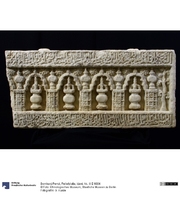Gujarati marble in East Africa
Type:
Cenotaphs,
Grave markers
Date:
Late thirteenth and fifteenth century (1305–45 for the piece found at Kilwa)
Medium:
Marble
Dimensions:
38.5 × 82.5 × 10 cm for the piece from Kilwa
Description:
Beginning in the thirteenth century, the port of Cambay (or Khambhat; Gujarat, India) exported carved marble panels to the Arabian Peninsula, southeast Asia, and coastal East Africa. The example reproduced here is a marble panel excavated from a cemetery at Kilwa Kisiwani, an island off the coast of modern-day Tanzania and an important port for Indian Ocean trade (see the range of imported ceramics uncovered there). The panel features a frieze with mosque lamps hanging in cusped arches. Along the top and bottom are Arabic inscriptions excerpted from the Qur'an.
Gujarati marble panels were commissioned for cenotaphs and tombstones or served as architectural features, supplementing coral as the primary building material of the Swahili coast (see, for example, the Great Mosque of Kilwa). The export of carved Gujarati marble for Muslim patrons peaked between the late thirteenth and fifteenth centuries. In addition to the example from Kilwa, pieces of a marble mihrab from Cambay are preserved in Mogadishu's Fakhr ad-Din Mosque (thirteenth or fourteenth century).
Gujarati marble panels were commissioned for cenotaphs and tombstones or served as architectural features, supplementing coral as the primary building material of the Swahili coast (see, for example, the Great Mosque of Kilwa). The export of carved Gujarati marble for Muslim patrons peaked between the late thirteenth and fifteenth centuries. In addition to the example from Kilwa, pieces of a marble mihrab from Cambay are preserved in Mogadishu's Fakhr ad-Din Mosque (thirteenth or fourteenth century).
Relevant Textbook Chapter(s):
9,
10
Repository and Online Resources:
• The Kilwa Kisiwani slab is now in Berlin's Ethnological Museum.
• Read more about trade with the Swahili Coast in an article by Vera-Simone Schulz.

